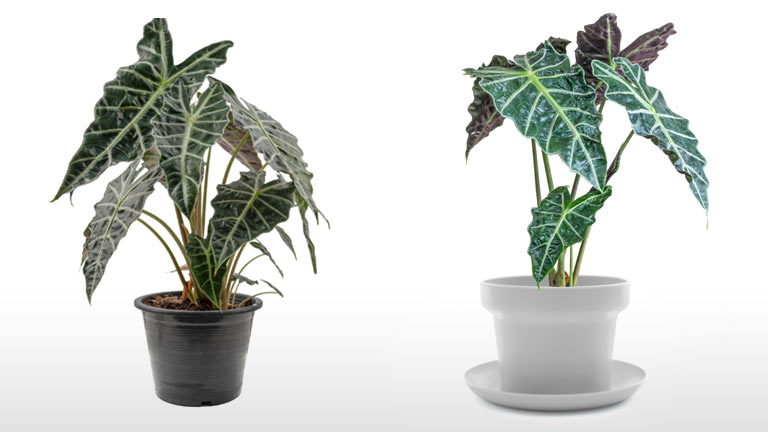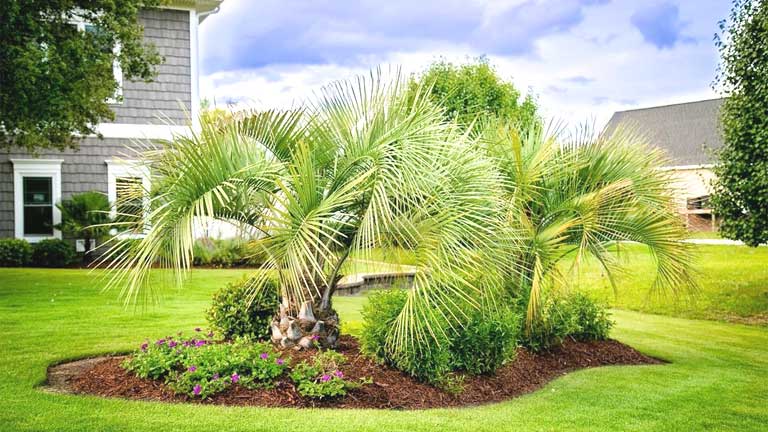
The arrow leaf is a tropical houseplant with very decorative leaves. However, the extraordinary houseplant makes some demands on the care. Now read everything you need to know about the care of the alocasia.
The arrow leaf (Alocasia), also known as tropical arum or elephant’s ear, is a popular houseplant that originates from the tropics. The decorative leaves grow on long stalks.
General information about the arrow blade
The arrowhead belongs to the aroid family (Araceae). Their home is in the tropical and subtropical areas of Asia to Australia. Varieties of Alocasia sanderiana are mainly used as houseplants. More than 79 species of the plant are known. The rhizomes of the giant taro (Alocasia mycorrhizas) are used as food and cooked like potatoes.
The plants are evergreen and grow herbaceously, which means that they do not become woody. The plants have large, simple, stalked true leaves that grow on long stalks. As houseplants are species and cultivars with stems that are solid or striped and leaves that are solid or multicolored.
The flowers of the arrow leaves consist of the bract (spatha) and the piston (spadix), which has a male and female section, as is usual with the arum family. Berries develop from the flowers.
Location and soil
The arrow leaf needs a semi-shady location with high humidity. This is particularly difficult in winter, which is why the tropical root feels particularly comfortable in conservatories or a closed flower window.
Alternatively, you can spray the leaves frequently with water or place the plant on a water-filled bowl of pebbles. Direct sunlight should be avoided. In summer, the arrowhead feels at home in a sheltered, semi-shady spot in the garden or on the balcony. The location should be evenly warm. Temperatures of around 15 degrees are tolerated for a short period of time.
Plant and care for
The soil in the Akolasia plant pot should be evenly moist, but not permanently wet. You should pour off excess irrigation water from the cachepot about 20 minutes after watering because the plant does not tolerate waterlogging. The substrate should therefore dry out before the plant is watered again. Rainwater that is low in lime or stagnant water is best suited for watering. In winter, the arrow blade needs less water, so it has to be watered sparingly.
From April to September, it is best to fertilize the tropical root once a week with green plant fertilizer.
Report alocasia
Since the arrow leaf grows quickly, it has to be repotted almost every spring. You can tell when the plant pot has become too small when the roots come to the surface and the pot is completely rooted. When repotting, shake off as much of the old soil as possible and cut off dead roots.
High-quality potting soil is recommended as a substrate.
Tip: The arrowhead likes slightly acidic soil. So mix some leaf soil under the substrate, fertilize with coffee grounds or occasionally add a small splash of vinegar to the irrigation water. Some sphagnum moss that you mix under the substrate has also proven useful.
Care mistakes, diseases, and pests
The roots of the tropical root do not tolerate waterlogging and quickly begin to rot if the soil is permanently too wet. When the leaves become light and pale, you should “dry out” the plant quickly, i.e. remove it from the potting soil, cut off rotten roots and plant the plant in new, structurally stable potting soil and keep it only slightly moist. Brown edges usually indicate that the air is too dry. Here you should take measures to increase the humidity. If the leaves turn brown overall, the cause may be that the soil temperatures are too low. Place the plant pot on a wooden board or styrofoam board if the plant is on a cool window sill.
Spider mites or whitefly infestation can occur, especially in winter. Frequent airing is recommended as a preventive measure.
Propagate alocasia
The easiest way to propagate arrowhead is by dividing the rhizomes. The best time is spring when the plants are repotted. Cut off a rhizome and divide it into small pieces. Let them dry out a bit so they don’t start to rot in the soil, and then plant them in a pot with well-drained soil.
Species and varieties
Varieties of Alocasia sanderiana or Alocasia x amazonica, also known as skeleton plants, are mainly used as indoor plants. Small varieties of the skeleton plant include ‘Polly’ and ‘Bambino Arrow’. Those who have more space can opt for the ‘Calidora’ variety, which has large green leaves, or ‘Portadora’, whose stems have brown-red spots. The ‘Black Velvet’ variety is particularly striking. It has almost black leaves so that the almost white leaf veins stand out strongly. Alocasia Metallica has oval to heart-shaped green leaves that are up to 40 centimeters long with darker veins that shimmer metallically.




